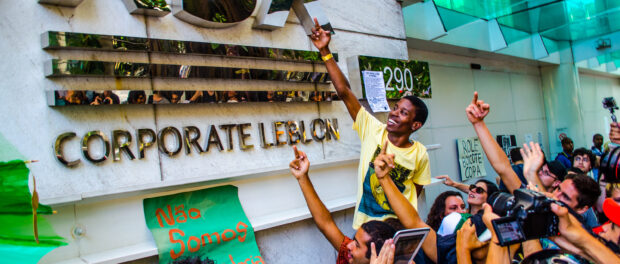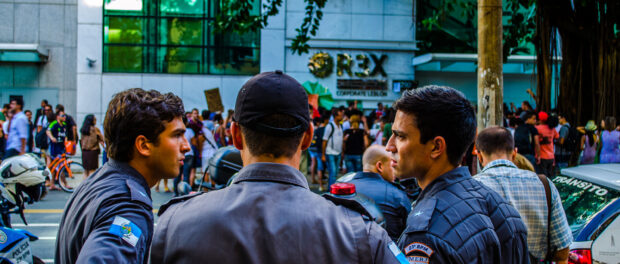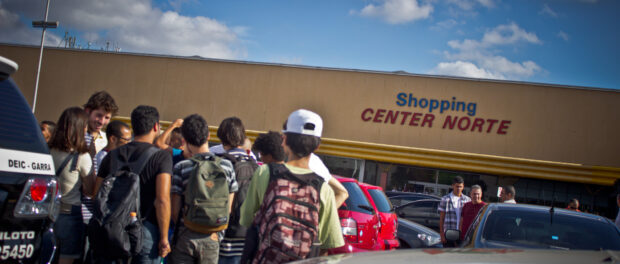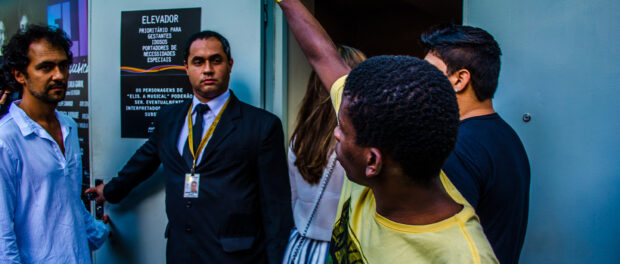
This post is the second of three RioOnWatch contributions to Blog Action Day 2014 in which bloggers around the world reflect on this year’s theme: Inequality. Check out our series of articles marking this day.
The lead-up to the 2014 World Cup in Brazil was tumultuous. The world watched as Brazilians, angry at a rise in bus fares in the context of the exorbitant levels of spending for the upcoming sporting mega-events, took to the streets in an upsurge of protests in June 2013. The preparations for the 2014 World Cup and 2016 Olympic Games not only revealed the continuing deep inequalities within Brazil–for example, forced evictions of favela residents have been carried in name of creating the desired infrastructure for the events–but also served as an opportunity for debate and activism. In this context, Brazil experienced one peculiar and rather brief phenomenon: the rolézinhos in Brazilian shopping malls. Despite taking place for only a couple of months, between the end of 2013 and beginning of 2014, they questioned a number of long-term, deep-rooted socioeconomic inequalities and patterns of spatial segregation of contemporary Brazilian cities, a feature of a number of metropolises around the globe.
Shopping malls, the locus of the citizenship of consumerism
How did the rolézinhos achieve this? The word “rolé” means “casual, small walk”, and this is how they started off: as nothing more than get-togethers in shopping malls of hundreds, sometimes thousands of young people, residents of the peripheries of cities such as São Paulo–the first to experience the phenomenon in its current form–Rio de Janeiro, Belo Horizonte and others. Organizing the gatherings through social media, the groups would go for a walkabout in shopping malls, the quintessential place of exclusivity, luxury and consumerism in Brazilian cities.
The rolézinhos seem to have been intended as a mere leisure activity by some, if not most of the attendees. According to the São Paulo rolézinho organizer Paulo Barros, 16, “the goal is to meet new people, enjoy ourselves, take lots of pictures, then post them on social networks. We did not go with the objective of creating confusion.” Others, however, such as Jefferson Luís, 20, who planned a rolézinho event at the São Paulo mall Shopping Internacional de Garulhos, and Franklin Rabelo, 23, organizer of a rolézinho at Shopping Iguatemi, in Brasília–which never happened because the authorities closed the mall on the planned day–had political reasons. They stated it as a reaction against Brazil’s social segregation and the lack of investments in places of leisure in their home neighborhoods in the less privileged areas of the city. For Franklin, Shopping Iguatemi “is a symbol of social segregation that exists in the city” and the event was organized “to demand investments in policies such as sport and leisure so that young people have access to public spaces for entertainment beyond shopping malls.”
However, it is maybe not so much the intentions and reasons for attending rolézinhos that make their political dimension clear. It was the reaction they caused. It soon became evident that rolézinhos were not welcome in malls. Shopping mall and store managers showed their fear of a crowd of low-income Afro-Brazilian youngsters who gathered with the intention of having fun but who were perceived as potentially dangerous. The fear of disorder, chaos and violence that underlies the logic of the creation of spaces of forced homogeneity, predictability, respectability and exclusivity such as malls–what anthropologists have named ‘fortified enclaves’–had rarely before been so obvious. Soon, the rolézinhos were criminalized by mall administrators, the police and mainstream media, who reported robberies and complained about the ‘disorder’ caused by the attendees. Shopping Leblon for instance, located in one of Rio de Janeiro’s wealthiest neighborhoods, closed its doors on January 19, the day of an announced rolézinho. In the same month, a number of São Paulo malls such as JK Iguatemi and Itaquera were granted injunctions against rolézinhos.

This simple act of association in shopping malls speaks to the faults in the urban planning of Brazilian cities, most explicitly, as already mentioned, the lack of public spaces of leisure and cultural activities for young people, especially in less privileged areas.
Leisure is then relocated to private spaces of consumption such as malls. It is not possible to separate urban planning in Brazil from the country’s patterns of inequality and segregation, since social relations are expressed in the organization of space, which in turn feeds back into how citizens, residents of the city, can interact with one another.
Brazilian geographer Milton Santos (1926-2001), for example, studied in-depth how the relations of production have a geographic dimension and explored the ‘geographies of inequality’ of Third World countries, or how the dimensions of inequality impact on the organization of geographic space and vice-versa. Furthermore, a person’s surroundings in many ways determines their access to resources, such as public services and education, and therefore can either improve or cap their social mobility. In his words, in O Espaço do Cidadão:
“Every man is worth the place in which they are: his value as producer, consumer, citizen, depends on their location in the territory. Therefore, the possibility of being more or less a citizen depends to a large extent on the spot of the territory where he is. While one place becomes the condition of their poverty, another place could, in the same historical moment, facilitate access to those goods and services that are theoretically owed to them, but that in fact they lack.”
Urbanization in Brazil has expressed and further reinforced the country’s unequal relations, where social values have been subordinated to economic interests in a framework of increasing consumerism and decreasing democracy. The rising number of shopping malls, in the context of the rise of gated communities in Brazil, tells us something about the state of Brazilian inequality.
Rolezinhos as a political movement
The rolézinhos are an expression of the city’s young periphery residents’ take on their place in this sociospatial inequality. They want ‘in’ on the consumerism and leisure facilities of privileged areas, and this is also a claim to citizenship. This claim to citizenship is explained in the following words of Brazilian sociologist Vera Malaguti Batista, when she writes about the criminalization of poverty and marginality:
“A certain discourse on crime has to be repeated ad infinitum and ad nauseum to be fundamental to the management of the poor, those who are not to frequent the mall, the temple of citizenship consumption. Who said that our boys dying or killing for a Nike cap are not fighting for the citizenship offered by this moment of capitalism?”
In a capitalist system such as ours, purchasing power and consumption are confused as well as intertwined with citizenship. A person’s class is a defining factor of that person’s access to rights and citizenship in a state such as Brazil, where the Constitution guarantees the formal equality and inclusion of Brazilians, but the substantive distribution of rights is still done along the lines of privilege and unequal power relations. As James Holston argues, the poor do not have the privilege of having rights. Instead, they are criminalized and repeatedly excluded from the city and from citizenship through a discourse of fear, crime and violence reinforced in the media and the growing US-led private security business, which has seen an average annual growth of 15-20% for the last eight years and has boomed during the preparations for the 2014 World Cup and 2016 Olympics.
This is why the rolézinhos make sense as a political movement. In fact, the first rolézinho was explicitly political. It took place in 2000, in the Rio Sul mall in Rio’s upper-middle class Botafogo neighborhood, as the documentary Hiato (2008) demonstrated. That year, members of the homeless movement decided to go for a ‘walkabout’ in Rio Sul as a form of protest against their exclusion. The documentary shows how the reactions to that group are strikingly similar to the ones afforded to the recent wave of rolézinhos, the latter not always organized with explicitly political motivations. Stores refused to serve the homeless, perplexed at their presence, closing stores and calling the police. It seems that, fourteen years later, no lessons were learned from that innovative form of protest.
The rolézinhos were brief and quickly lost their spotlight in the media. Before store and mall managers, the media, scholars and general public could make sense of them in a sustained way, they were criminalized and, in turn, these attempts to stop and control them politicized the rolézinhos. Organized out of a mix of recreational and political motivations, they unveiled the underlying socioeconomic and spatial inequalities and segregation of Brazilian cities, which have witnessed an increase in the number and size of gated communities, in surveillance as well as the privatization of public spaces. The criminalization of the poor is linked to a discourse of insecurity under advanced capitalism, and this becomes extremely clear in the case of rolézinhos. The mere presence of a high number of low-income periphery youngsters raised security concerns in malls, which are supposed to serve as a paradise of safety for the consumerist rich in a country perceived as ravaged by violence, crime and insecurity.
This brief moment of political resistance and leisure has sparked a longer discussion on the present and future of Brazil’s democracy. Having said this, it is opportune to finish here with the words of Milton Santos, who, looking to that future, stated that profound change will not come “from the United States or Europe. It will come from the poor, the ‘primitive’ and ‘backward’, as we are considered in the Third World. These cannot come from obese classes. They cannot see much. The poor are the holders of the future.”
Désirée Poets was born and raised in Rio de Janeiro and has been undertaking her Ph.D. at the University of Aberystywh, Wales, where she also completed her Masters in Postcolonial Politics. Her interests lie in urban political mobilizations, currently with a focus on race and ethnicity in urban spaces.



